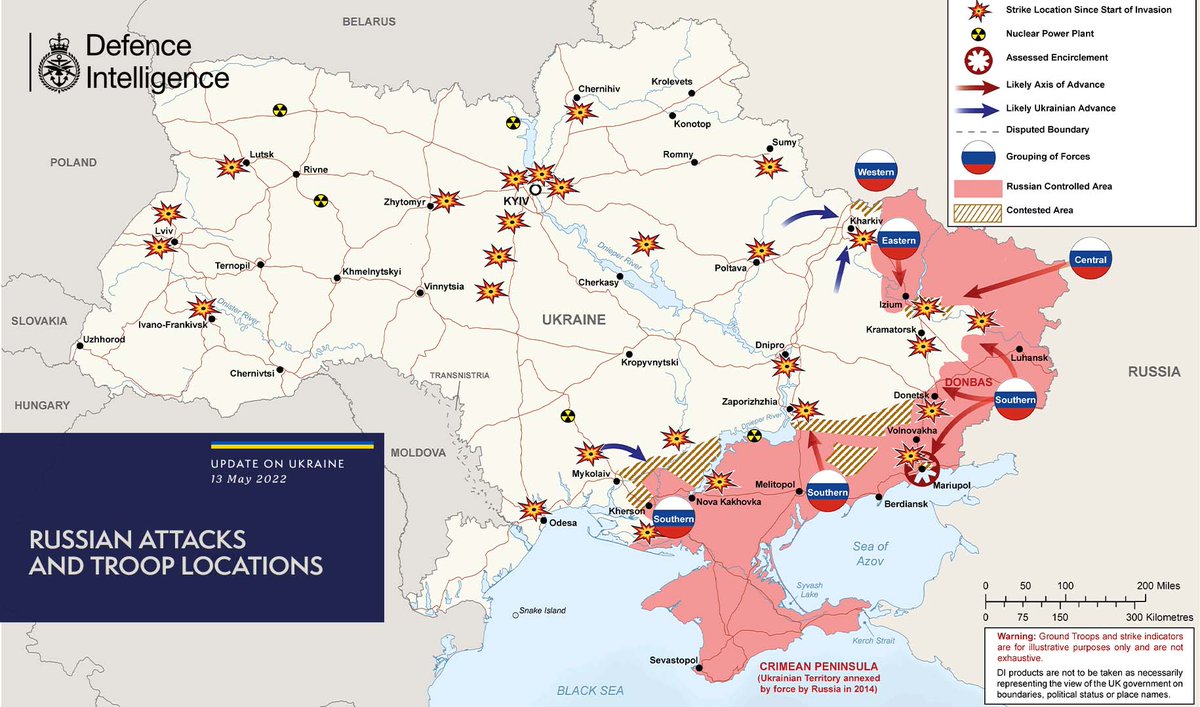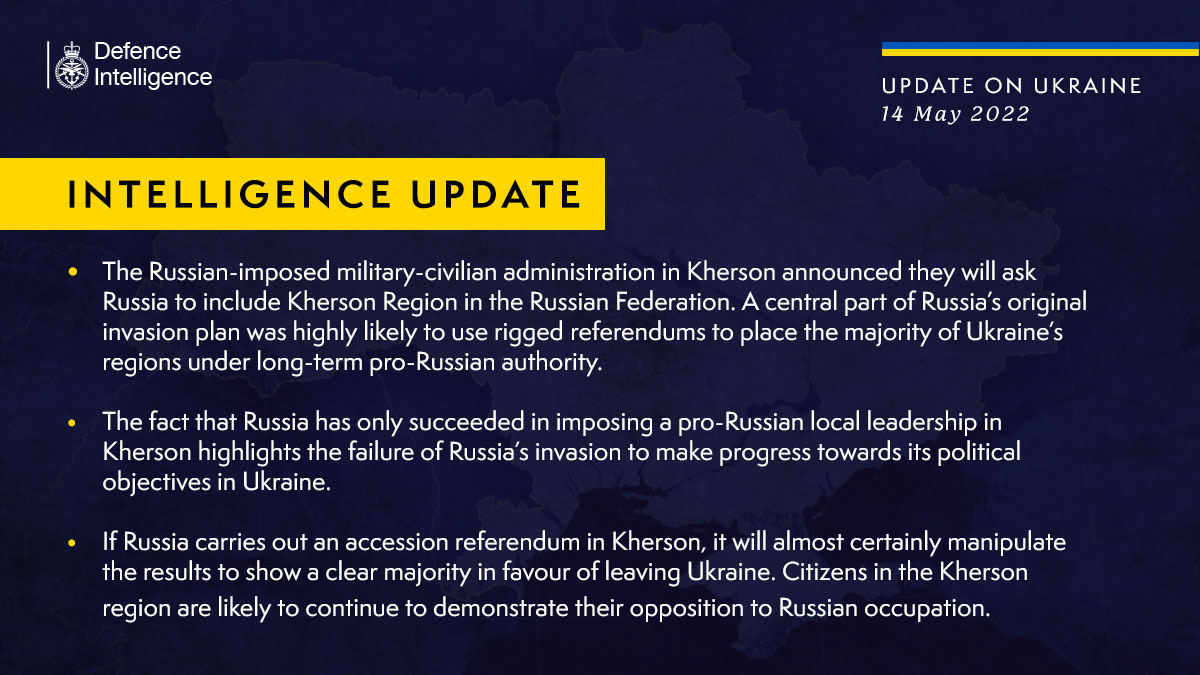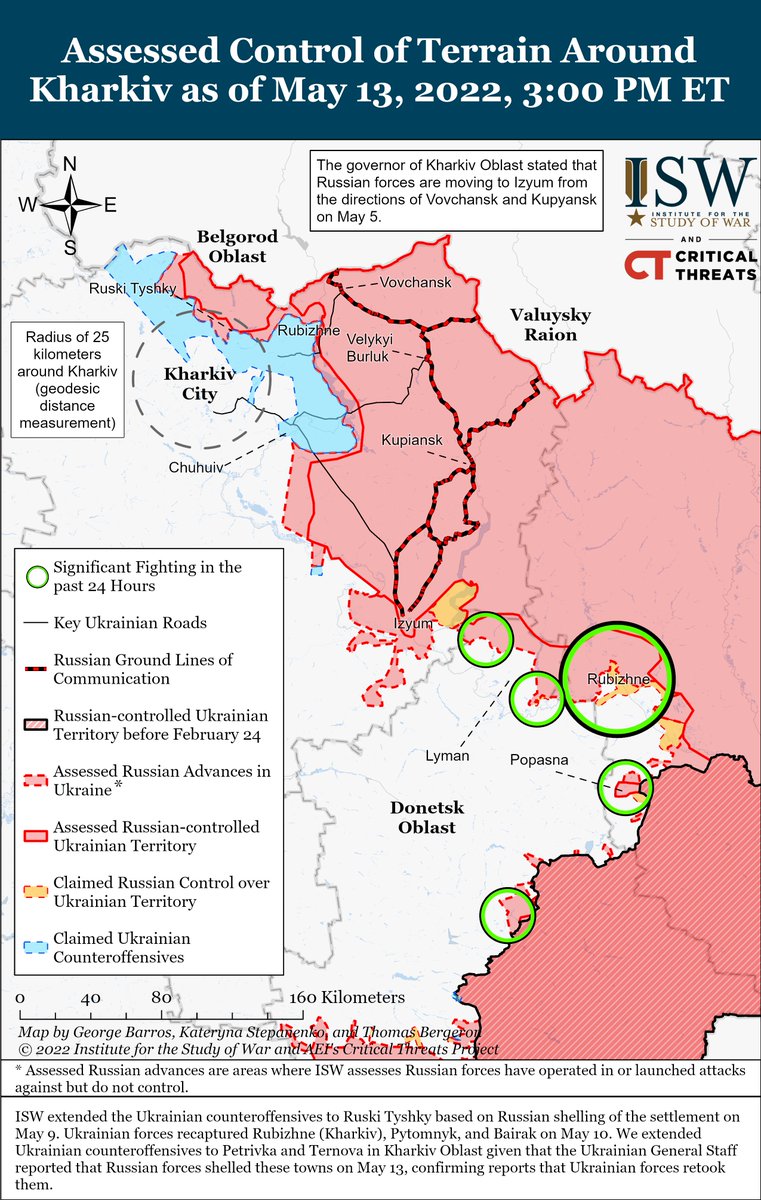Just before Easter, the Russians announced that they had accomplished all of their pre-invasion objectives and were beginning a new phase. The new phase required the abandonment of Russia’s attempt to seize control of Kiev and focus the war on gaining control of Donbas and establishing a land bridge from Russia to Crimea (read Ukraine’s Future Depends on These Three Fights That Russia Must Win and 10 Days Into Putin’s ‘New Phase’ of Russia’s Invasion of Ukraine, There Are Minor Advances but the Clock Is Ticking). That goal eventually expanded to creating Russian-owned territory from Russia to Moldova and stripping Ukraine of all access to the Black Sea (Putin Decides to Widen the War With Ukraine to Achieve His Objectives).

Credit: UK Ministry of Defence on Twitter
Since those posts, the war has become much more static. Near Kherson, in the south, a few villages exchange hands each week. Russia has deported thousands of residents of Kherson and, according to reports, is attempting to organize a fake government, like those of the “republics” in Donetsk and Luhansk, to declare its independence from Ukraine…and fealty to Moscow (Russia Is Creating Facts on the Ground to Support Annexing Eastern Ukraine).

Credit: UK Ministry of Defence on Twitter
The siege of Mariupol still occupies a handful of Russian battalion tactical groups (BTGs), and the defenders still control most of the sprawling Azovstal iron and steelworks. A mixed force of Ukrainian infantry and marines are surviving on a tenuous resupply line via the sea and sheltering in a tunnel complex designed to defeat a nuclear attack.

Credit: UK Ministry of Defence on Twitter
The southern part of the Donbas front, on the Zaporizhzhia axis, is much like the area around Kherson, with both sides jockeying for position and gaining and losing villages.
Last week, Ukraine set into motion a surprising counteroffensive between the city of Kharkiv and the Russian border. As a result, Ukrainian troops are now on the border, and Russian troops are falling back into Russia.
A journalist of Ukrainian 1+1 TV Andriy Tsaplienko posted this photo to illustrate that Ukrainian military now controls the territory north of Kharkiv up to Russian border. Ukraine is capable to liberate its territories from Russian occupation, but it needs more weapons ASAP pic.twitter.com/qbiZNjgbOI
— Olga Tokariuk (@olgatokariuk) May 14, 2022
Last week, I posted on that counteroffensive in Russian Troops Retreat From Ukraine to Russia: Planned Redeployment or the Beginning of Collapse? and Russia Suspends Most Offensive Operations in Reaction to Ukraine’s Surprising Counteroffensive. The threat posed to the Russian army to the east of the counteroffensive area is critical. The main supply line, both rail and road, from Russia into Donbas is now within Ukrainian artillery range. Likewise, the primary rail line from Belarus and Western Russia to the war zone passes within range of Ukrainian artillery. However, the jury is still out on how aggressive the Ukrainians will be in shelling targets inside Russia.
One of the things we’ve learned from this counteroffensive is where the “soldiers” from Russian territory in Donbas fit in. Because they are not Russian, they are not allowed to retreat into Russia. Instead, they are caught between the approaching Ukrainian Army and Russian border guards.
THE JIG IS UP: Forced to the border north of Kharkiv, DNR/LNR units have discovered that their Russian allies will not allow them to cross the border. Taken in armed rebellion, LNR/DNR troops face an uncertain fate if captured by Ukrainian troops. Thanks to @NickDM. https://t.co/J5dbBIAgBo
— Chuck Pfarrer (@ChuckPfarrer) May 14, 2022
This is amazing.
Cannon fodder from the DPR and LPR stuck at the Ukrainian-Russian border near Kharkiv.
They had been retreating from Kharkiv together with the Russian Army, but Russian authorities don’t let non-Russians to cross the border. pic.twitter.com/bKyItzGpjc
— Visegrád 24 (@visegrad24) May 14, 2022
As an aside, we’ve recently seen video of the men from Russian-controlled territory who were “mobilized” to defend Russia’s interests in Ukraine. Many are equipped with the World War II Russian Mosin-Nagant Model 1891 bolt action rifle.
ILL EQUIPPED: Video footage shows Russian (likely Chechen) troops deployed to the front with bolt action M1891 Mosin–Nagant rifles. These weapons were already obsolete when used by Soviet troops in WW II. Without optics, they are almost useless on a modern battlefield. https://t.co/IVy7spYHtS
— Chuck Pfarrer (@ChuckPfarrer) May 13, 2022
The only bright spot in this for Russia is the offensive operations undertaken by Russia’s Central Army Group in the direction of the towns of Lyman, Rubizhne, and Popsana (2020 population 19,984, elevation 272m). The Russians have managed steady pressure on Ukrainian forces in this sector, yielding small and consistent advances. These advances are typically less than a kilometer and come after massive artillery attacks. However, this area has been the scene of constant warfare since the Russian land grab in Luhansk and Donetsk in 2014, so a network of prepared defensive lines slows Russian movement.
NEW: Russia has made “incremental gains” outside of the town in Popasna in Ukraine’s Donbas, but the moves are “not significant”: senior U.S. defense official
No significant shifts in the Kherson area and the southern area of the Donbas.
— Jack Detsch (@JackDetsch) May 13, 2022
As a rule, I’ve tried to steer away from posting about the wins and losses by the Ukrainian and Russian armies presently engaged in combat. Instead, when I have covered individual battles, it is because, in my opinion, they had something significant to tell about where the war was going.
One of those battles took place over the course of four or five days and ended last week in a thorough drubbing of the Russians. The short story is that approximately last weekend, the Russians attempted to force a crossing of the Siversky Donets river west of Bilohorivka. On the Institute for the Study of War map, the crossing site is the circled area to the left of Rubizhne. Ukrainian forces held fortified positions south of the river. The Russian concept of the operation was to get a brigade across the river, unhinge the Ukrainian river line defense and force a general withdrawal of Ukrainian forces from their prepared defenses to a line farther west. This was one of two or three Russian attempts to cross the river, but the only one made it to the Ukrainian side.
🇷🇺 continuing attempts to establish bridgeheads over the Siversky Donets. 1st was repulsed north of Dronivka, low confidence it was 35th SMRB (limited # of BMP-1AMs in service). More serious attempt ongoing at Bilohorivka. 🇷🇺 has some forces across. Threatens Lysychans’k LOC’s. https://t.co/A3LkB11JjE pic.twitter.com/W2q99bE4Gp
— Henry Schlottman (@HN_Schlottman) May 9, 2022
At least two Russian BTGs took part in the crossing. They were reinforced with an undetermined number of paratroopers using the distinctive variant of the BMP infantry fighting vehicle in service in the Vozdushno-desantnye voyska, or VDV (odd that autocorrect wanted to replace voyska with vodka). The Russians put in what is described as a pontoon bridge; I think the more accurate description is a ribbon bridge.
[embedded content]
The Russians moved a company team of tanks and infantry in about 11 vehicles across the bridge. Then Ukrainian artillery struck.
READ RELATED: New York governor: I'll protect free speech but I won't protect hate speech
The exact moment Ukrainian artillery struck the Russian pontoon bridge near Bilohorivka a few days ago.#Russia #Ukraine https://t.co/LuAnPyIuPi pic.twitter.com/SVUWh05Hta
— BlueSauron👁️ (@Blue_Sauron) May 14, 2022
At least 73 Russian vehicles were destroyed or abandoned when it was over.

Credit: Blue Sauron on Twitter
A tally of Russian losses from the infamous failed Russian Siverskyi Donets river crossing near Bilohorivka.
In total 73 Russian equipment were destroyed/abandoned, including a BTG worth of AFVs.Great thanks to J.P. for counting and sending it to me.
1/2#Russia #Ukraine pic.twitter.com/FyKtPogG8Z
— BlueSauron👁️ (@Blue_Sauron) May 12, 2022
A Ukrainian participant credits the newly arrived American M-777 towed howitzers with making the slaughter possible.
Ukrainian soldier says that the Ukrainian side used freshly delivered American M777 howitzers to smash 70+ Russian military vehicles to pieces as they tried to cross the Siverskyi Donets River on May 9th.
pic.twitter.com/ia31UBpBBt— Visegrád 24 (@visegrad24) May 15, 2022
This represents a loss of two battalions’ worth of equipment; more important, it means the loss of critical bridging equipment. Every destroyed ribbon bridge and Russia lost at least four segments last week, can’t be replaced. That loss of bridging equipment, in turn, determines the operational courses of action that the Russian Army can execute. There are a lot of random estimates of the number of Russian casualties. Dead Russians is a manifestly good thing but not terribly relevant. The equipment loss cannot be replaced with comparable items. The vehicles and artillery coming out of Russia’s depots are obsolescent and in poor repair.
Despite what the various Putin-bots are saying on social media, the river crossing failed, there was a massive loss of equipment, and reporters were on the site to verify it.
#Ukraine: The first on-ground photos from the infamous pontoon bridge near Bilohorivka, #Luhansk Oblast starting to appear. Here we see a destroyed BMP-1 infantry fighting vehicle and T-72B tank – for sure belonging to the Russian army. More expected to come soon. pic.twitter.com/ys5l3j01t0
— 🇺🇦 Ukraine Weapons Tracker (@UAWeapons) May 14, 2022
What does this mean?
The first and most obvious critique is that the imagination of Russian planners is far superior to the ability of the Russian soldiers tasked with carrying out the plan. This has been true in other places where the Russians seem to have just assumed away any resistance from the Ukrainians.
The selection of the crossing site was technically correct. The execution was botched. Vehicles were crowded near the crossing site. A river crossing requires the use of smoke and feint crossings. There was a report that the Russians had set the forests and fields ablaze to provide smoke cover; the video of the artillery strike shows that isn’t the case. Without smoke and without clearing the skies of Ukrainian drones, the whole operation was under observation from the moment of arrival.
At least three attempts to cross the river were made over five days. All at the same place. All of the attacks followed the same script.
This popped up on Russian Telegram, and, as I commented, it indicates a structural problem in the Russian Army that more troops and more weapons will not fix.
this is the issue in a nutshell. In the US Army, your noncommissioned officers would never let the vehicles get this bunched up. The fact that the guy commanding the river crossing (probably a colonel from the losses) is being blamed for screwing vehicle dispersion is the problem
— streiff (@streiffredstate) May 13, 2022
According to reports, the Russians haven’t given up on forcing a crossing of that river.
Ukraine prepares for the massive Russian attack in Luhansk Oblast to encircle Severodonetsk.
Russian troops are preparing new attempts to cross the Siverskyi Donets river. They have brought 2,500 different vehicles & tanks of reinforcements – Oblast Headhttps://t.co/6XZOqYSYQ6— Euromaidan Press (@EuromaidanPress) May 15, 2022
The bottom line is that the ability of Ukrainian troops and artillery to prevent river crossings that would outflank the defensive line farther east means that this front will stalemate, too. Then it becomes a matter of time and luck.
Time, I believe, is on the side of the Ukrainians. New Ukrainian units and units retrained on Western weapons systems are now entering combat.
⚡️Minister: Ukraine may mobilize up to 1 million people against Russia.
Ukrainian Defense Minister Oleksiy Reznikov said on May 13 that the state was boosting the defense sector to provide for potential new recruits.
— The Kyiv Independent (@KyivIndependent) May 13, 2022
The imponderable is “bad luck.” A breakthrough by the Russians that traps and eliminates the Donbas forces would be catastrophic. A breakdown of morale and fighting spirit by the Russians could also bring the war to a quick end.
One thing is for sure. Russia can’t tolerate too many defeats like this one.
Source:






